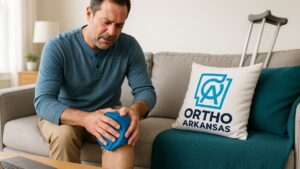How to Treat Knee Pain at Home and With Professional Care
Recurring aches around your knees can make stairs feel like mountains and grocery runs feel like marathons. Knowing how to treat knee pain starts with understanding what’s causing it, then matching treatment to that cause. In the sections below, we’ll break down common problems—each with targeted solutions and clear signs that it’s time to call in expert help.
Why You Might Have a swollen knee
A swollen knee often means fluid has built up inside the joint capsule. You might notice puffiness, warmth, or a tight feeling when you bend.
How to treat it:
- Rest and compress. Take weight off the leg and wrap with an elastic bandage.
- Ice in intervals. Fifteen minutes on, fifteen minutes off, several times a day.
- Elevate. Prop up your leg above heart level whenever possible to reduce fluid pooling.
- Anti‑inflammatory meds. Over‑the‑counter NSAIDs can ease pain and swelling, but check with your pharmacist if you have other health conditions.
If the swelling lasts more than a week or keeps coming back, a drainage procedure or imaging study may be needed to rule out infection or ligament damage.
Combating stiff knee pain
Morning stiffness or a grinding sensation can mean cartilage wear, scar tissue, or muscle tightness. stiff knee pain often improves once you “warm up,” but it shouldn’t hurt to loosen a joint.
How to treat it:
- Gentle range‑of‑motion drills. Heel slides and seated leg swings boost circulation without load.
- Heat therapy. Warm showers or heat packs relax tight tissues before exercise.
- Targeted stretching. Focus on calves, hamstrings, and quadriceps to offload the joint.
Persistent stiffness could signal early arthritis—an orthopedic evaluation helps you get ahead of further deterioration.
Managing chronic knee pain
If discomfort sticks around for months, you’re dealing with chronic knee pain. This state can erode sleep, mood, and overall activity levels.
How to treat it:
- Activity modification. Swap high‑impact workouts for cycling or swimming to stay fit without pounding joints.
- Physical therapy. A therapist can correct faulty movement patterns that keep pain simmering.
- Bracing or taping. Offloading braces shift force away from sensitive areas; kinesiology tape supports soft tissue healing.
- Injections. Corticosteroid or hyaluronic acid injections provide medium‑term relief while you strengthen supporting muscles.
Tackling knee joint inflammation
Ongoing irritation inside the joint lining—knee joint inflammation—often feels hot and looks red. Autoimmune arthritis, gout, or overuse can all inflame the synovium.
How to treat it:
- Dietary tweaks. Limit processed sugars and add omega‑3‑rich foods to calm systemic inflammation.
- Medication review. Prescription disease‑modifying drugs or biologics may be needed if an autoimmune issue is at play.
- Low‑impact cardio. Gentle motion pumps nutrient‑rich fluid through the joint, helping it clear inflammatory byproducts.
Lab work and imaging guide your doctor’s choice of medication or injection therapy.
Everyday Advice for knee pain and treatment
The phrase knee pain and treatment covers a wide range of do’s and don’ts:
- Mind your shoes. Worn‑down soles change knee alignment with every step—rotate pairs regularly.
- Strengthen the hips. Glute weakness lets knees cave in; bridges and side‑lying leg lifts build support from above.
- Control body weight. Even a 10‑pound loss can slash knee load by up to 40 pounds per step.
- Listen to early signals. Sharp twinges while squatting mean stop and reassess form or intensity.
Following these basics prevents many minor irritations from snowballing into major setbacks.
Quick self‑care checklist
- Alternate ice and heat based on whether swelling or stiffness dominates.
- Stretch and strengthen daily, not just on exercise days.
- Track pain on a 0‑10 scale to spot trends early.
- Book routine check‑ups if you have arthritis or a past knee injury.
When to Consult a knee surgeon
Home care has limits. A knee surgeon should evaluate:
- Recurrent locking or giving‑way episodes
- Visible deformity or a popping event followed by instant swelling
- Pain that interrupts sleep despite meds and therapy
- X‑ray or MRI evidence of significant cartilage loss or ligament rupture
Modern surgical options range from arthroscopic meniscus repair to partial or total joint replacement. A well‑timed procedure can reset the clock on knee health, letting you return to sports or simply walk pain‑free again.

Take the next step toward lasting relief
Visit our homepage for detailed guides, exercise videos, and insurance information that help you plan your recovery journey.
Call us directly or fill out our form to schedule a personalized assessment and learn exactly how to treat knee pain for your specific condition.













